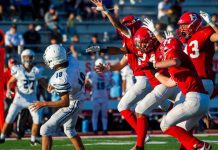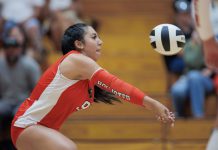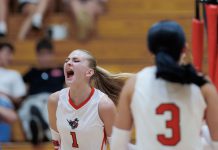Butt-kicks? Hineys? The warm-up routine for the San Benito Lady
‘Baler volleyball team may seem like a joke, but for the defending
Central Coast Section champs, coming to fall practices out of shape
isn’t even an option.
Hollister – Butt-kicks? Hineys?
The warm-up routine for the San Benito Lady ‘Baler volleyball team may seem like a joke, but for the defending Central Coast Section champs, coming to fall practices out of shape isn’t even an option.
A typical practice for the Lady ‘Balers begins with a three-minute jog, six sets of hineys, butt-kicks, skips, karaoke, fast shuffle and slow shuffle, lunges, three-minute squats, two minutes of crunches and push-ups, and two more minutes of crunches and leg lifts.
Stretch. Water. Begin practice.
“It builds up your stamina,” said captain Aly Sharp. “We don’t get tired in the games, that’s for sure.”
Of course, Coach Dean Askanas says the girls come to fall practices ready to go anyway, so some additional conditioning can only help. As the saying goes, what doesn’t kill you will only make you stronger.
“It’s hard enough skill-wise to make the team, and if you’re out of shape, you’re not going to have enough time to learn the skills,” Askanas said. “We focus on leg strength and core strength. Their core strength is where all their speed and explosiveness is going to come from. You have to have a strong core to make fast, explosive moves.”
For some, like captain Emily Kortsen, staying game-ready comes a little easier when playing volleyball year-round. When the SBHS senior isn’t playing for the Lady ‘Balers, she’s competing on the Main Beach Volleyball Club out of Aptos.
“I don’t dislike it because it gets you in shape. It’s intense,” she said of the team’s practices. “There’s a lot of preseason to get used to it.”
Added Sharp, “You get used to it real quick.”
One may have thought the off-season conditioning for Bri Romero would have been a little more difficult than usual. In last year’s NorCal Championships, Romero went down with a torn patella tendon, and wasn’t cleared to play until July.
“I did physical therapy until July,” Romero said. “I would run, but it’s not the funnest thing to do. I’d do it to prepare.”
Romero said there was nothing unusual about her preparation for the upcoming season, with the exception that she couldn’t play on her club team, City Beach Volleyball Club.
Teammate Justine Hunter also plays club ball for the Hang Ten Volleyball Club out of San Jose, almost leaving little time to fall out of shape. Club volleyball seems to fill the void that is left when the school season – which begins with preparation in June and lasts through November – is over.
Of course, it’s not all volleyball all the time. Hunter is on the track team, while Romero does track and basketball, keeping the conditioning up and making the transfer to volleyball in June seamless.
“A lot of your strength comes from the center core of your body,” Romero said. “You can’t come into practice saying, ‘Oh, it’s volleyball. Whatever.'”
“People think, with volleyball, you just stand there,” Sharp said. Added Romero, “If you come into a match (out of shape), you’re going to be fatigued.”
Sharp, a blocker, says when she’s in the weight room, she’s working on the leg press, leg lifts and leg extensions in order to vault herself up into the air and above the net for a clean block. Others, like Hunter, are working on their arms for setting purposes, while all of them seem to work on their mid-section for explosiveness.
Not only that, but all of them run on their own time to increase leg strength.
Kortsen said volleyball may seem “laid back” when compared to basketball or soccer – fast-paced sports where the athletes have increased stamina – but Romero added that in volleyball, the players need to have more muscle tone.
“A lot of the girls play club (volleyball) and there is open gym,” Askanas said. “The conditioning is really going to be on their own, but once we get going, we do a lot of conditioning.”
Said Kortsen, “He doesn’t let us slack off … I would never slack off.”









